Propagation of an unwanted species: Clematis akoensis
I only grow one Clematis. As an exchange for a defective Chilean Bellflower (Lapageria) lacking the normal coloration (all white), I was sent a couple rooted cuttings of Clematis akoensis.
Clematis akoensis is presumably undesirable because of its bicolored flowers, which are scented unlike most modern hybrids. See link at bottom for a photo I found online (not mine). Presumably because of its appearance, the flower has not been grown outside of its native Taiwan until very recently. It is a tropical species, tolerating little or no frost. So perhaps its lack of appeal is understandable.
A search of the Clematis forum, and Gardenweb as a whole for Clematis akoensis yields no results, indicating how unpopular this species is.
However, I think it's important that we all propagate some pure species (of whatever plants), not just manmade hybrids. So I decided to start some cuttings of Clematis akoensis, pictured below. All are single node, soft cuttings. I dipped the tips in Rootone (0.1% IBA) and am incubating them in moist perlite, under lights, indoors (roughly 70 F).
Perhaps some will object to the propagation of such a species that is clearly defective compared to many hybrids. I'll check the cuttings weekly for two months, and report back. If anyone can guess how many of the four cuttings successfully root (ties broken by a guess as to timing of rooting) I can send one of the rooted cuttings for postage. The recipient can then dispose of it or otherwise deal with it as they deem appropriate.
The 4 cuttings:

Here is a link that might be useful: {{gwi:592348}}
Comments (25)
mark4321_gw
Original Author9 years agoHere's a photo of the leaves, which instead of being solid green, have white speckles on them. In the background is another species, a Passionflower, Passiflora loefgrenii, which also is bicolored.
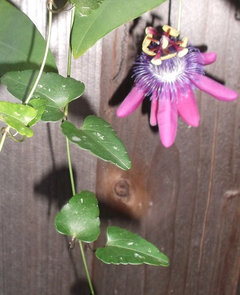
Related Professionals
Windham Landscape Architects & Landscape Designers · Erie Landscape Architects & Landscape Designers · Newcastle Landscape Architects & Landscape Designers · Roxbury Crossing Landscape Architects & Landscape Designers · Westwood Landscape Contractors · Chelmsford Landscape Contractors · Los Banos Landscape Contractors · Mahwah Landscape Contractors · Mastic Beach Landscape Contractors · New Berlin Landscape Contractors · New Providence Landscape Contractors · Webster Groves Landscape Contractors · York Landscape Contractors · San Pablo Landscape Contractors · Ferguson Landscape ContractorsWhitelacey
9 years agoI agree. Oftentimes the species is more lovely than the hybrids. Plus, there is a lot of genetic material that should be grown on. I think the flowers are gorgeous!
Linda
NHBabs z4b-5a NH
9 years ago"unwanted" and "undesireable" seem to me rather unfair descriptive tems based on just a search of gardenweb. Rare I would agree with, but it is an endangered species in its native Taiwan, so its rarity is not unexpected. Also, its need for either a greenhouse or a warm climate also adds to its rarity, but neither of those make it undesireable. It is a lovely plant, and its blue stamens make it that much more attractive rather than less IMO.
If you look at forums where clematis collectors and breeders post, you will find it is discussed. GW attracts gardeners, many of whom are just beginning and so rare plants will be less likely to be discussed. I will see if Garden Web allows me to add a link to a different forum (though if you want to see the photo you have to join.)
Here is a link that might be useful: Garden Buddies Clematis akoensis
mark4321_gw
Original Author9 years agoI was joking at times, and I thought I was being obvious. Sorry if this created any confusion.
I assume some people did figure out that I was not serious in all of my comments. Clematis akoensis is obviously a stunning species. That should have been the first clue. The suggestion that someone could receive a rooted cutting, only to "dispose of it", was also not subtle. The offer of one of one of the cuttings is of course for real.
I have found the plant easy to grow so far in my climate, even over the winter. It was cool but frost free, with most winter temperatures around 60/40 F. While C. akoensis is from the tropics, Southern Taiwan does cool down considerably in winter. The fact that it is from a region with hot, humid summers, yet continues to grow over a Northern California winter, suggests that it might be possible outside in (nearly?) frost-free climates in both California and Florida.
The plant is surprisingly easy to propagate, which is why I'm attempting such minimal cuttings.
I find this strange, but I'm told that the all white form is considered more "desirable".
gardenper
9 years agoI thought your title referred to you not wanting to propagate it, but somehow had to. However, if it refers to other people not wanting to propagate it, I would ignore that totally. If you want to , go ahead!
As for the lack of information, it may relate more to not having that as a common clematis. You mentioned that it is native or mostly available in Taiwan, so I would even imagine that is a condition right there. It's just not a common or readily available variety here to be talked about. Or like the case with some of my hobbies and interests, there is plenty of discussion about it in Chinese or in Asian circles, but not in English.
mark4321_gw
Original Author9 years agoThe "unwanted" in the title of the post is there to make it ridiculous and ironic. The plant is of great interest to those familiar with it, including top nurseries and botanical gardens. If people are unaware, all it takes is a photo.
If I had enough material, I'd start a lot more cuttings. I would like to see it bloom before distributing it too much. Appparently it blooms reasonably small, so that will hopefully happen early next year.
I thought I read once that Taiwan actively kept it from leaving the country. The idea being that it was a national treasure that only belonged there. I may be misremembering this; perhaps it was merely due to laws protecting an endangered plant. My impression, though, is that there has been considerable interest in C. akoensis outside of Taiwan for a while. It was simply not available.
TulsaRose
9 years agoThanks for the input, Mark. This is a lovely Clematis species. While browsing for more info, ran across the common name and got a chuckle...it's rather musical. :-)
"ping dong tie xian lian"
flowers_galore
9 years agoMark,
I have come across this post looking for tropical Clematis. Other than SAC, the only other I found is Clematis smilacifolia / Tropical clematis listed that can grow in South Florida. So if you know a source for this, I am very interested. I do note that you got this as rooted cutting.
Thank you.
Here is a link that might be useful: Clematis smilacifolia
Guinnevtra
9 years agoI'm going to say that one will take, because the rest of the numbers are taken. It is a LOVELY plant, and the flowers are just WOW! Is it fragrant?
mark4321_gw
Original Author9 years agoSorry to not reply to this thread in so long! At first it was because Gardenweb strangely stopped letting me know of responses. Then those magically restarted.
However at that point I wasn't sure what I had. When I started the cuttings they fairly soon got hit by fungus. One survived, leafless, for the longest time. It finally started to grow. Below is a photo from Sept. 9. It has since grown more. Guinnevtra guessed the correct number.
To answer the question about fragrance--yes, and it's supposed to be like honey from one description.
I fully expected to get 4 plants out of 4 cuttings. I've since switched to just rooting in a glass of water to avoid the fungus problem. That works well, and my first try I got 4 of 4 to root.
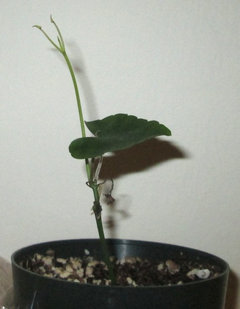
mnwsgal
9 years agoThanks for updating. I have been wondering how the cuttings were doing.
Congrats on the one survivor.Guinnevtra
9 years agoThat's great! I'm happy that at least one survived for you! You aren't having any problems rooting the other cuttings in water? I have been experimenting with several plants using cuttings in water...it works for gardenias and wisteria, and a couple of plants that I don't have a name for, but doesn't work for acacia, or citrus. I have accidentally propagated my clematis (I'm unsure which kind it is), by not tying it up as well as I should have, and one of the vines touched the ground in a couple places. It is now growing roots in two places along the vine, yay!
mark4321_gw
Original Author9 years agoHi Guinnevtra,
The cuttings in water rooted fine. One of them was slower than the others--I think maybe it was a single node cutting. I just finally (!) potted it up but took a photo first.
I like to root in water where possible, and this works for a surprising number of plants. Perlite is, I think, most likely to work for the largest number of cuttings. Layering is frequently overlooked. I suspect that most plants that can be rooted in water are trivial by layering. Unfortunately the reverse is not true... One plant that I have that self-layers in nearby pots (and roots easily in water) is Passiflora sanguinolenta. A really amazing plant that is difficult to propagate, but can be layered easily (but apparently only by some) is Passiflora parritae. Unfortunately, its climate requirements (cool but frost free) limit it to cool areas of the California coast. It's off topic, but I suspect most members of this forum wouldn't mind a photo....
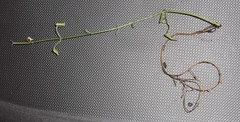
mark4321_gw
Original Author9 years agoAs promised, an off-topic photo of Passiflora parritae, climbing a tree at the San Francisco Botanical Garden (Strybing Arboretum). The vine died back severely in last year's freeze, but has partially recovered. Many other plants there were not so lucky.
The flowers are huge, by the way.
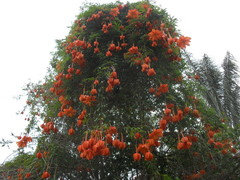
Here is a link that might be useful: Article on propagating P. parritae by layering, PDF file, p. 4-11
mnwsgal
9 years agoWow, that is a very impressive passiflora. I have not been there at the time this is in bloom.
dbarron
9 years agoI think that white and purple species clematis is gorgeous...propagate away and I wish I could grow it.
mark4321_gw
Original Author9 years agoI'm told that last summer was the best ever blooming of Passiflora parritae. The photo was from early August, near the peak. There are usually flowers between about May through November. Surprisingly, the plant can be hard to find if one does not know where to look, and the Arboretum intentionally does not list the location in their database. Apparently they are worried people will swipe cuttings (which probably almost always fail).
Last winter it hit maybe 27 degrees, with a freeze on probably 3 mornings. Most of the vine was killed back. It was blooming nicely when I was there in August, but nothing a week ago.
The plant does well in San Francisco because of the cool, humid climate, which averages about 67/55 in the summer, and 10 degrees cooler in the winter. It can take a little more heat, but I've never heard of it succeeding anywhere but California near the coast (or Bay). In theory it could also be grown in a greenhouse kept at the appropriate temperature (heated in winter, cooled in summer most places). However it would take a lot of space.
mark4321_gw
Original Author9 years ago(duplication deleted)
This post was edited by mark4321 on Mon, Sep 22, 14 at 15:35
Daan Kuiper
6 years agoBy the way, I do realise that meanwhile it is 2017, but is the any clematis akoensis available







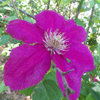
mark4321_gwOriginal Author